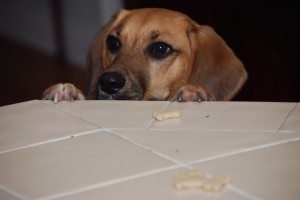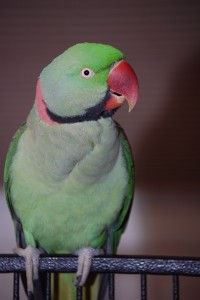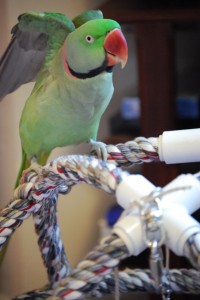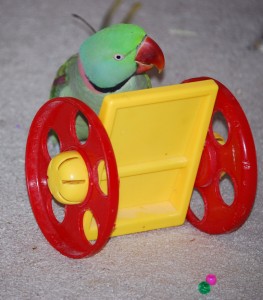pet behavior
ABC’s of Pet Behavior, Part Two
Note: Please visit my pet behavior blog at http://www.SoMuchPETential.com/blog.
(from my Hyde Park Living column)
Last month I explained the ABCs of behavior and we can use them as the most positive, least intrusive way of managing and modifying our pet’s behavior. This month I thought I’d show you a little how it works.
First, let me recap. Applied behavior analysis is a systematic approach to solving behavior problems by changing the environment in which the behavior occurs. It involves looking at the very specific behavior (such as a bird biting or screaming) and the related environmental context that signals and reinforces it. We ask, “What happened *immediately* prior to the behavior (antecedent) to set the whole ball rolling?“ And, “What happened *immediately* after the behavior to reinforce it (consequence)?“
I’m going to use the example of our family dog, Sam, who has an earned reputation for pawing my mom when we eat or standing with his two front paws on the table looking for a prize. For the purpose of this column, I will label that set of  observable behaviors as ‘bad table manners.’
observable behaviors as ‘bad table manners.’
The setting event for ‘bad table manners’ is our sitting around the table with food. The consequence may be any number of things…my mom trying to ignore him but sometimes hugging him, sometimes telling him he’s bad, sometimes giving him a treat. You get the picture?
Since I know under what conditions his behavior is highly predictable, I can decrease the value of that behavior with antecedent strategies. I can play rough with him just prior to our sitting down to get him tired and less motivated to have ‘bad table manners.’ I can (and always do) make him a foraging toy that he only gets before we eat and that keeps him busy for awhile. (I break up pieces of treats, and intertwine them in knotted plastic grocery bags that are then stuffed into a heavy rubber ball.)
Another thing I have done was teach him an alternative behavior (actually he knows a lot of behaviors) that, when we are sitting at the table, he knows in black & white terms that *if * he does that behavior next to me – which I chose as sitting or laying down – *then* he will get reinforced with attention and small pieces of food. (Okay, I admit I feed him some at the table but only when he is doing a behavior I taught him is acceptable.) At the same time, I have removed all positive consequences of his bad table manners (which meant when he jumps or paws, I simply turn my back and push my plate to the center of the table).
Guess which behavior he does more of now? Heck, if I were him and I REALLY wanted a taste off that plate, and knew the only sure fire way of getting a sample was to sit or lay down, I think I’d choose to sit or lay down too. And I’d do it pretty darned fast.
What is so wonderful about this is that punishment never had to be used, only empowerment. Sam has learned to succeed because I am clear cut in teaching him what I want him *to* do and because I make learning fun. Let me say that again. At every step along the way…learning is fun.
To read part one, please click here.
Do You Know The ABC’s Of Pet Behavior?
NOTE: I have a new pet behavior blog located at http://www.SoMuchPETential.com/blog. Thanks!
(past Hyde Park Living column)
Do you know your ABC’s?
Well that’s a strange question you may be saying to yourself. Isn’t this a pet behavior column?
Yep, it sure is. And the ABC’s I’m talking about are not related to spelling words. They are instead what I have been taught to help me understand why a behavior occurs so that as a pet owner and teacher, I can effectively set my animals up for success by influencing their behavior in the most positive/least intrusive way.
Let me back up. What I really would like for you to get from this column is a basic understanding that blaming an animal for doing anything you don’t want him to do is simply counterproductive. All behavior happens because it is serving a purpose for that animal. We may never know at any given time what our animal is feeling or thinking when he jumps on us or chews up a garden hose but we don’t need to know to still set our animal up to succeed. Using the ABC assessment, we can modify the animal’s environment and modify his behavior without any use of force or punishment.
The science of behavior
Applied behavior analysis is a systematic approach to solving behavior problems by changing the environment in which the behavior occurs. It involves looking at the very specific behavior (such as a bird biting or screaming) and the related environmental context that signals and reinforces it. We ask, “What happened *immediately* prior to the behavior (antecedent) to set the whole ball rolling?“ And, “What happened *immediately* after the behavior to reinforce it (consequence)?“
 There you have it…the A (antecedent), B (behavior), and C (consequence)’s.
There you have it…the A (antecedent), B (behavior), and C (consequence)’s.
All too often when our pet is doing something we disapprove of we don’t even realize that we are responsible for reinforcing the very action we don’t want to see. Or in the heat of the moment, we end up punishing our pet – which can have detrimental side effects (the subject for a future column) and serves no teaching function.
Using the ABC assessment tool allows us to consider how we can rearrange the antecedents so that the problem behavior is never set into motion to begin with – and we can set into motion an acceptable behavior instead. Then we can reinforce the heck out of the acceptable behavior. Guess which behavior you’ll see more of?
In my next column I’ll work through a specific example of using the ABC analysis in solving a pet behavior issue.
Solving Problem Parrot Chewing With Enrichment
NOTE: I have a new pet behavior blog located at http://www.SoMuchPETential.com/blog. Thanks!
(a Hyde Park Living column written a number of years ago when my dear Chester was still with us)
In the days before Barnaby joined our flock, there was just Chester, Dreyfuss and me living together in a large two bedroom apartment. It actually was a wonderful place with many of the rooms being larger than those in my house and the large sliding glass window in the dining room made for a scenic view of the woods in the back. Pink floor length curtains hung from its side with a hand made valence (made by me) stretching across the top.
Chester and Dreyfuss stayed in the dining room, their cages arranged on a wall at either end of the table.
It made for some interesting meetings (I work from my home) and dinners with the family. Whoever thought only dogs begged for food has certainly never met my guys!
That was long before I had ever heard of behavioral analysis, and creating an enriching environment, well, that meant putting some acrylic toys in their cages, right??? I got them at the pet store, and they were labeled ‘bird toys’ after all.
I did a lot of things differently back then, and, as a result, so did the guys. Take for example those flowing, opaque pink curtains that were no longer transparent to the sun’s afternoon rays by the time I bought a house. If you’re ever looking for an awesome playgym for your parrot, I’ve got a suggestion. To Chester, they were the greatest thing next to safflower seeds. He’d slide down his cage stand, waddle across the floor and climb to his heart’s content. Up, down, right, left. If he was on the outer edge, he could swing it around so that only his head would stick out. And, if I didn’t find him while he was playing monkey on the curtains, he’d make it all the way up to the valence. I can’t tell you how many times I’d walk out to find him hanging upside down. When he’d see me, he’d tilt his head up as if to say ‘look mom, look at me!’
I was so frustrated because I couldn’t stop him, but at the same time, if you’ve ever seen an Alexandrine hanging upside down with such a comical look about him, you can’t help but laugh. It’s just so funny.
look about him, you can’t help but laugh. It’s just so funny.
Then there was the time when I was on the telephone in a back bedroom and suddenly I heard C*R*U*N*C*H. That was the sound of a dining room chair being disassembled by a beak that didn’t have anything better to chew on. <sigh>
Needless to say, I was determined when we moved, that history was NOT going to repeat itself. And thankfully now, I have the knowledge to prevent it. (at least so far – and it’s been nine years)
It’s easy to look back on the situation now and see how Chester’s environment wasn’t setting him up for success, at least success through my eyes.
With a behavioral analysis hat on, let’s look at his curtain climbing antics.
Background: Chester is activity and Lisa deprived.
Antecedent: curtains were in view
Behavior: Chester waddled over and climbed the curtains
Consequence: sensory feedback – stimulation from his having to use his beak and feet activity – he was busy and engage; social – if I came out, he’d get my attention
Probable Future Behavior: When Chester is activity and Lisa deprived, he’ll continue to climb the curtains
So, what have I done differently to set him up for success?
Well, honestly, I really just needed to do some antecedent changes to prevent him from destroying things here and it has solved our problem. I have created a much more enriching environment. I even keep their cage doors open while I’m working in my basement and the only reason Chester will come off his cage is if something scares him. But I’m prepared for that too.
Chester, and all of my birds, have a lot to do during the day to keep them busy. I spend hours each week making strands of knotted hemp and beads that I hang all over the inside and outside of their cages. I wrap almonds in cloth or a box or paper cup for Chester and Dreyfuss. I have portions of a phone book wrapped in string on the cage floor of Chester’s cage and hanging toys for Barnaby, my Timneh Grey, to hang from.
The list goes on but you get the picture. They are busy if they want to be, and if they want to nap, that’s fine too.
But in the instance that Chester should come to the ground (and now I put him there too when I’m cleaning cages or watching tv), I’ve made some play stations for him. I got a mirrored toy from a human baby store and he can spend hours with it, so much so that I got a second one for the television room. (Scattering some beads or resting a tub of activity items next to it makes it even more reinforcing.) I bought a cheap plastic round snow sled and placed an Orbit play gym on top, tying strands of beads to it. This is also in the television room, next to the mirror toy. Chester receives such positive sensory and activity reinforcement for playing with these toys that there’s no reason for him to search out a dining room chair or curtain.
that Chester should come to the ground (and now I put him there too when I’m cleaning cages or watching tv), I’ve made some play stations for him. I got a mirrored toy from a human baby store and he can spend hours with it, so much so that I got a second one for the television room. (Scattering some beads or resting a tub of activity items next to it makes it even more reinforcing.) I bought a cheap plastic round snow sled and placed an Orbit play gym on top, tying strands of beads to it. This is also in the television room, next to the mirror toy. Chester receives such positive sensory and activity reinforcement for playing with these toys that there’s no reason for him to search out a dining room chair or curtain.
 And I’d much rather laugh at him rolling his mirror toy around than hanging from my hand made valence any day!
And I’d much rather laugh at him rolling his mirror toy around than hanging from my hand made valence any day!














